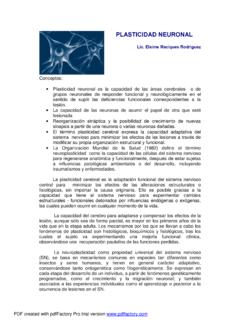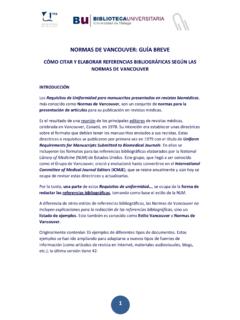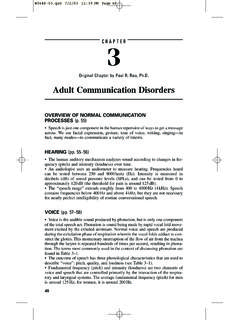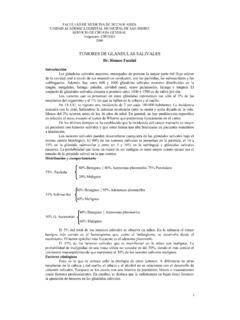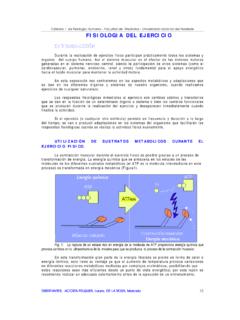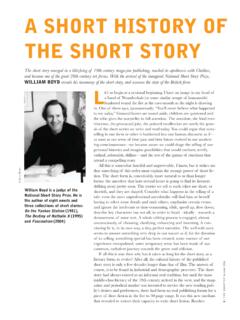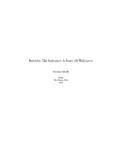Transcription of A SHORT HISTORY OF BLOOD TRANSFUSION - Infomed
1 NBS Scientific & Technical TrainingSTT-042 (Jan 2006)NATIONAL BLOOD SERVICEA SHORT HISTORYOFBLOOD TRANSFUSIONCOMPILED AND WRITTENBYPHIL LEAROYDSCIENTIFIC & TECHNICAL TRAINING MANAGER LEAD DDRLEEDS BLOOD CENTRENBS Scientific & Technical TrainingSTT-042 (Jan 2006)2 INTRODUCTIONThe practice of BLOOD TRANSFUSION , that is the transference of BLOOD from the circulationof one individual to that of another for practical therapeutic purposes, is of relativelyrecent origin. Although it only became a practical possibility during and shortly afterthe Second World War the concept of TRANSFUSION has a longer HISTORY . Thepracticality of TRANSFUSION has, to some degree, paralleled and in some instances beenthe consequence of, developments in other sciences.
2 The idea though of thetheoretical beneficial effects of BLOOD TRANSFUSION has been recognised for over threecenturies. This older HISTORY is based on the traditional idea of BLOOD as being the living-force of the body. Man must have recognised that loss of BLOOD was frequentlyassociated with weakness and death. This was manifested by Greeks and Romanscommitting suicide by opening a vein (involving cutting their wrists). BLOOD wasrecognised as having numerous mysterious properties, including initially that ofcarrying both the mental and physical characters of its owner. Early attempts atreplacing lost BLOOD involved the drinking of BLOOD by the patient.
3 By choice, this wasfrom a young, healthy, fit person or animal. The legend of the vampire originates fromthis concept. This somewhat mystical fascination with the properties of BLOOD is tosome degree still with us BEGINNINGST here are many early documented references to the use of BLOOD , for what can be atbest described as medicinal purposes. One of the first of these relating to a TRANSFUSION is contained in the seventh book of the Metamorphoses, by Ovid, whowrote in 43BC, describing how (the witch) Medea rejuvenated Jason's aged fatherAeson as follows:"Medea took her unsheathed knife and cut the old man's throat lettingall of his BLOOD out of him.
4 She filled his ancient veins with a rich elixir. Received through his lips and wound, his beard and hair no longerwhite with age, turned quickly to their natural vigour, dark and lustrous;his wasted form renewed, appeared in all the vigour of bright youth".Medea's remarkable success was achieved with an elixir brewed in a bronze cauldroncontaining the following ingredients:".. root-herbs, seeds and flowers, strong juices and pebbles from thefarthest shores of oceans east and west; hoar-frost taken at the full ofthe moon, a hoot owl's wings and flesh, a werewolf's entrails, a fillet ofa snake, the liver of a stag and the eggs and head of a crow whichhad been alive for nine centuries.
5 "Medea's practice as a transfusionist was not confined to this single event, since sheis later reported to have killed Pelias, by pretending to perform a similar miracle onhim, having first gained his confidence by apparently changing an aged sheep into alamb!In addition to these early mythical writing, there are several noted citations inthe Old Testament indirectly bearing on ( BLOOD ) TRANSFUSION . These have a socialimpact to the present day, relating to the denial of a BLOOD TRANSFUSION by certainpersons, on religious is believed that the ancient kings of Egypt apparently bathed in BLOOD ,believing such baths to ".
6 Resuscitate the sick and rejuvenate the old andNBS Scientific & Technical TrainingSTT-042 (Jan 2006)3incapacitated", as well as believing it to be a cure for elephantiasis! In classical timesthe Romans and Greeks, as well as bathing in BLOOD , have reportedly drank it. Plinythe Elder , wrote in the 1st Century AD, describing how spectators rushed into thearena to drink the BLOOD of dying gladiators. These people did this because they feltthat such BLOOD was especially beneficial since the athletes were strong and brave,qualities that they believed were present within, and therefore transmissible by, theblood of the person concerned.
7 The situation apparently became so bad that byAD193, a decree was issued by Septimus Severus prohibiting this practice. Pliny theElder also wrote: ".. a man's BLOOD rubbed upon himself will relieve him of pain" andthat the drinking of BLOOD ".. as if out of a loving cup" was a cure for epilepsy. Aboutthe same time, the writer Galen advised that the drinking of the BLOOD of a weasel, or ofa dog, was a cure for rabies. Similarly, ancient Norwegians reportedly drank the bloodof seals and whales as a remedy for epilepsy and these references refer to the drinking of BLOOD or the application ofblood to the skin, an ancient Hebrew manuscript refers to an actual possibletransfusion as follows:"Naam, leader of the armies of Bed-Adad, King of Syria, afflicted byleprosy, consulted physicians, who in order to cure him drew out theblood from his veins and put in that of another.
8 "An early recognition of the dangers of the custom of ingestion of BLOOD , as well asprobably the first rather fanciful description of what could be described as themanagement of an adverse reaction, is contained in the works of the 13th Centurywriter Petro de Abano, who wrote:"He who drinks of menstrual BLOOD or that of a leper will be seen to bedistracted and lunatic, evil minded and forgetful, and his cure is todrink of daisies powdered and mixed with water of honey, and to bathin tepid water and to copulate with girls according to the law natural,and to play with pretty girls and young boys; and the antidote is to eatserpents whose heads and tails have been cut off with the edge of apalm frond.
9 "Since most of the ancient and medieval references probably refer to the ingestion ofblood, rather than to its infusion, it is in fact difficult to determine when the firstauthentic attempt at TRANSFUSION was actually performed. One of the most frequentlyquoted candidates for this noteworthy honour is Pope Innocent VIII, Giovanni Cibo, whowas reputedly transfused some time between 1490 and 1492. Villari, someconsiderable time later recounted the incident, claiming that the Pope had some sortof illness (in the light of present knowledge this was probably chronic renal disease),that rendered him semi-comatose.
10 This was described as being so profound at timesthat the Pope was mistakenly thought to be one occasion, after all means to revive the Pope had failed, it is reportedthat a physician (or mystic) of dubious reputation, named Abraham Meyre, appeared inthe court and promised to save the Pope s life by transfusing him with the BLOOD ofyoung donors . Apparently, three young 10-year-old shepherd boys were selected asdonors and Villari states that the BLOOD of the dying Pope was passed into the veins ofone of the boys, ".. who gave him his own in exchange". The process was apparentlyrepeated with the other two boys. All three boys apparently died shortly after theprocedure, possibly as a result of air embolism, but there was no change to thePope's condition.
